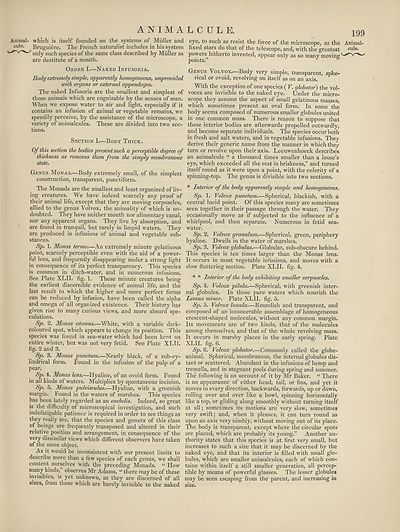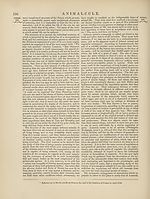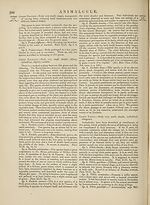Encyclopaedia Britannica > Volume 3, Anatomy-Astronomy
(207) Page 199
Download files
Complete book:
Individual page:
Thumbnail gallery: Grid view | List view

A N I M A
Animal- which is itself founded on the systems of Muller and
cule. Bruguiere. The French naturalist includes in his system
only such species of the same class described by Muller as
are destitute of a mouth.
Order I.—Naked Infusoria.
Body extremely simple, apparently homogeneous, unprovided
with organs or external appendages.
The naked Infusoria are the smallest and simplest of
those animals which are cognizable by the senses of man.
When we expose water to air and light, especially if it
contains an infusion of animal or vegetable remains, we
speedily perceive, by the assistance of the microscope, a
variety of animalcules. These are divided into two sec¬
tions.
Section I.—Body Thick.
Of this section the bodies present such a perceptible degree of
thickness as removes them from the simply membranous
state.
Genus Monas.—Body extremely small, of the simplest
construction, transparent, punctiform.
The Monads are the smallest and least organized of liv¬
ing creatures. We have indeed scarcely any proof of
their animal life, except that they are moving corpuscles,
allied to the genus Volvox, the animality of which is un¬
doubted. They have neither mouth nor alimentary canal,
nor any apparent organs. They live by absorption, and
are found in tranquil, but rarely in limpid waters. They
are produced in infusions of animal and vegetable sub¬
stances.
Sp. 1. Monas termo.—An extremely minute gelatinous
point, scarcely perceptible even with the aid of a power¬
ful lens, and frequently disappearing under a strong light
in consequence of its perfect transparency. This species
is common in ditch-water, and in numerous infusions.
See Plate XLII. fig. 1. These minute creatures being
the earliest discernible evidence of animal life, and the
last result to which the higher and more perfect forms
can be reduced by infusion, have been called the alpha
and omega of all organized existence. Their history has
given rise to many curious views, and more absurd spe¬
culations.
Sp. 2. Monas atomus.—White, with a variable dark-
coloured spot, which appears to change its position. This
species was found in sea-water wdiich had been kent an
entire winter, but was not very fetid. See Plate XLII.
fig. 2 and 3.
Sp. 3. Monas punctum.—Nearly black, of a sub-cy¬
lindrical form. Found in the infusion of the pulp of a
pear.
Sp. L Monas lens.—Hyaline, of an ovoid form. Found
in all kinds of waters. Multiplies by spontaneous incision.
Sp. 5. Monas pulvisculus.—Hyaline, with a greenish
margin. Found in the waters of marshes. This species
has been lately regarded as an enchelis. Indeed, so great
is the difficulty of microscopical investigation, and such
indefatigable patience is required in order to see things as
they really are, that the species and genera of this class
of beings are frequently transposed and altered in their
relative position and arrangement, in consequence of the
very dissimilar views which different observers have taken
of the same object.
As it would be inconsistent with our present limits to
describe more than a few species of each genus, we shall
content ourselves with the preceding Monads. “ How
many kinds, observes Mr Adams, “ there may be of these
invisibles, is yet unknown, as they are discerned of all
sizes, from those which are barely invisible to the naked
L C U L E. 199
eye, to such as resist the force of the microscope, as the Animal-
fixed stars do that of the telescope, and, with the greatest cule.
powers hitherto invented, appear only as so many moving
Genus Volvox.—Body very simple, transparent, sphe¬
rical or ovoid, revolving on itself as on an axis.
With the exception of one species ( V. globator) the vol-
voces are invisible to the naked eye. Under the micro¬
scope they assume the aspect of small gelatinous masses,
which sometimes present an oval form. In some the
body seems composed of numerous smaller globules united
in one common mass. There is reason to suppose that
these interior bodies are afterwards propelled outwardly,
and become separate individuals. The species occur both
in fresh and salt waters, and in vegetable infusions. They
derive their generic name from the manner in which they
turn or revolve upon their axis. Leeuwenhoeck describes
an animalcule “ a thousand times smaller than a louse’s
eye, which exceeded all the rest in briskness,” and turned
itself round as it were upon a point, with the celerity of a
spinning-top. The genus is divisible into two sections.
* Interior of the body apparently simple and homogeneous.
Sp. 1. Volvox punctum.—Spherical, blackish, with a
central lucid point. Of this species many are sometimes
seen together in their passage through the water. They
occasionally move as if subjected to the influence of a
whirlpool, and then separate. Numerous in fetid sea¬
water.
Sp. 2. Volvox granulum.—Spherical, green, periphery
hyaline. Dwells in the water of marshes.
Sp. 3. Volvox globulus.—Globular, sub-obscure behind.
This species is ten times larger than the Monas lens.
It occurs in most vegetable infusions, and moves with a
slow fluttering motion. Plate XLII. fig. 4.
* * Interior of the body exhibiting smaller corpuscles.
Sp. 4. Volvox pilula.—Spherical, with greenish inter¬
nal globules. In those pure waters which nourish the
Lenina minor. Plate XLII. fig. 5.
Sp. 5. Volvox lunula.—Roundish and transparent, and
composed of an innumerable assemblage of homogeneous
crescent-shaped molecules, without any common margin.
Its movements are of two kinds, that of the molecules
among themselves, and that of the whole revolving mass.
It occurs in marshy places in the early spring. Plate
XLII. fig. 6.
Sp. 6. Volvox globator.—Commonly called the globe-
animal. Spherical, membranous, the internal globules dis¬
tant or scattered. Abundant in the infusions of hemp and
tremella, and in stagnant pools during spring and summer.
The following is an account of it by Mr Baker. “ There
is no appearance of either head, tail, or fins, and yet it
moves in every direction, backwards, forwards, up or down,
rolling over and over like a bowl, spinning horizontally
like a top, or gliding along smoothly without turning itself
at all; sometimes its motions are very slow, sometimes
very swift; and, when it pleases, it can turn round as
upon an axis very nimbly, without moving out of its place.
The body is transparent, except where the circular spots
are placed, which are probably its young.” Another au¬
thority states that this species is at first very small, but
increases to such a size that it may be discerned by the
naked eye, and that its interior is filled with small glo¬
bules, which are smaller animalcules, each of which con¬
tains within itself a still smaller generation, all percep¬
tible by means of powerful glasses. The lesser globules
may be seen escaping from the parent, and increasing in
size.
Animal- which is itself founded on the systems of Muller and
cule. Bruguiere. The French naturalist includes in his system
only such species of the same class described by Muller as
are destitute of a mouth.
Order I.—Naked Infusoria.
Body extremely simple, apparently homogeneous, unprovided
with organs or external appendages.
The naked Infusoria are the smallest and simplest of
those animals which are cognizable by the senses of man.
When we expose water to air and light, especially if it
contains an infusion of animal or vegetable remains, we
speedily perceive, by the assistance of the microscope, a
variety of animalcules. These are divided into two sec¬
tions.
Section I.—Body Thick.
Of this section the bodies present such a perceptible degree of
thickness as removes them from the simply membranous
state.
Genus Monas.—Body extremely small, of the simplest
construction, transparent, punctiform.
The Monads are the smallest and least organized of liv¬
ing creatures. We have indeed scarcely any proof of
their animal life, except that they are moving corpuscles,
allied to the genus Volvox, the animality of which is un¬
doubted. They have neither mouth nor alimentary canal,
nor any apparent organs. They live by absorption, and
are found in tranquil, but rarely in limpid waters. They
are produced in infusions of animal and vegetable sub¬
stances.
Sp. 1. Monas termo.—An extremely minute gelatinous
point, scarcely perceptible even with the aid of a power¬
ful lens, and frequently disappearing under a strong light
in consequence of its perfect transparency. This species
is common in ditch-water, and in numerous infusions.
See Plate XLII. fig. 1. These minute creatures being
the earliest discernible evidence of animal life, and the
last result to which the higher and more perfect forms
can be reduced by infusion, have been called the alpha
and omega of all organized existence. Their history has
given rise to many curious views, and more absurd spe¬
culations.
Sp. 2. Monas atomus.—White, with a variable dark-
coloured spot, which appears to change its position. This
species was found in sea-water wdiich had been kent an
entire winter, but was not very fetid. See Plate XLII.
fig. 2 and 3.
Sp. 3. Monas punctum.—Nearly black, of a sub-cy¬
lindrical form. Found in the infusion of the pulp of a
pear.
Sp. L Monas lens.—Hyaline, of an ovoid form. Found
in all kinds of waters. Multiplies by spontaneous incision.
Sp. 5. Monas pulvisculus.—Hyaline, with a greenish
margin. Found in the waters of marshes. This species
has been lately regarded as an enchelis. Indeed, so great
is the difficulty of microscopical investigation, and such
indefatigable patience is required in order to see things as
they really are, that the species and genera of this class
of beings are frequently transposed and altered in their
relative position and arrangement, in consequence of the
very dissimilar views which different observers have taken
of the same object.
As it would be inconsistent with our present limits to
describe more than a few species of each genus, we shall
content ourselves with the preceding Monads. “ How
many kinds, observes Mr Adams, “ there may be of these
invisibles, is yet unknown, as they are discerned of all
sizes, from those which are barely invisible to the naked
L C U L E. 199
eye, to such as resist the force of the microscope, as the Animal-
fixed stars do that of the telescope, and, with the greatest cule.
powers hitherto invented, appear only as so many moving
Genus Volvox.—Body very simple, transparent, sphe¬
rical or ovoid, revolving on itself as on an axis.
With the exception of one species ( V. globator) the vol-
voces are invisible to the naked eye. Under the micro¬
scope they assume the aspect of small gelatinous masses,
which sometimes present an oval form. In some the
body seems composed of numerous smaller globules united
in one common mass. There is reason to suppose that
these interior bodies are afterwards propelled outwardly,
and become separate individuals. The species occur both
in fresh and salt waters, and in vegetable infusions. They
derive their generic name from the manner in which they
turn or revolve upon their axis. Leeuwenhoeck describes
an animalcule “ a thousand times smaller than a louse’s
eye, which exceeded all the rest in briskness,” and turned
itself round as it were upon a point, with the celerity of a
spinning-top. The genus is divisible into two sections.
* Interior of the body apparently simple and homogeneous.
Sp. 1. Volvox punctum.—Spherical, blackish, with a
central lucid point. Of this species many are sometimes
seen together in their passage through the water. They
occasionally move as if subjected to the influence of a
whirlpool, and then separate. Numerous in fetid sea¬
water.
Sp. 2. Volvox granulum.—Spherical, green, periphery
hyaline. Dwells in the water of marshes.
Sp. 3. Volvox globulus.—Globular, sub-obscure behind.
This species is ten times larger than the Monas lens.
It occurs in most vegetable infusions, and moves with a
slow fluttering motion. Plate XLII. fig. 4.
* * Interior of the body exhibiting smaller corpuscles.
Sp. 4. Volvox pilula.—Spherical, with greenish inter¬
nal globules. In those pure waters which nourish the
Lenina minor. Plate XLII. fig. 5.
Sp. 5. Volvox lunula.—Roundish and transparent, and
composed of an innumerable assemblage of homogeneous
crescent-shaped molecules, without any common margin.
Its movements are of two kinds, that of the molecules
among themselves, and that of the whole revolving mass.
It occurs in marshy places in the early spring. Plate
XLII. fig. 6.
Sp. 6. Volvox globator.—Commonly called the globe-
animal. Spherical, membranous, the internal globules dis¬
tant or scattered. Abundant in the infusions of hemp and
tremella, and in stagnant pools during spring and summer.
The following is an account of it by Mr Baker. “ There
is no appearance of either head, tail, or fins, and yet it
moves in every direction, backwards, forwards, up or down,
rolling over and over like a bowl, spinning horizontally
like a top, or gliding along smoothly without turning itself
at all; sometimes its motions are very slow, sometimes
very swift; and, when it pleases, it can turn round as
upon an axis very nimbly, without moving out of its place.
The body is transparent, except where the circular spots
are placed, which are probably its young.” Another au¬
thority states that this species is at first very small, but
increases to such a size that it may be discerned by the
naked eye, and that its interior is filled with small glo¬
bules, which are smaller animalcules, each of which con¬
tains within itself a still smaller generation, all percep¬
tible by means of powerful glasses. The lesser globules
may be seen escaping from the parent, and increasing in
size.
Set display mode to:
![]() Universal Viewer |
Universal Viewer | ![]() Mirador |
Large image | Transcription
Mirador |
Large image | Transcription
Images and transcriptions on this page, including medium image downloads, may be used under the Creative Commons Attribution 4.0 International Licence unless otherwise stated. ![]()
| Encyclopaedia Britannica > Encyclopaedia Britannica > Volume 3, Anatomy-Astronomy > (207) Page 199 |
|---|
| Permanent URL | https://digital.nls.uk/193760039 |
|---|
| Attribution and copyright: |
|
|---|---|
| Shelfmark | EB.16 |
|---|---|
| Description | Ten editions of 'Encyclopaedia Britannica', issued from 1768-1903, in 231 volumes. Originally issued in 100 weekly parts (3 volumes) between 1768 and 1771 by publishers: Colin Macfarquhar and Andrew Bell (Edinburgh); editor: William Smellie: engraver: Andrew Bell. Expanded editions in the 19th century featured more volumes and contributions from leading experts in their fields. Managed and published in Edinburgh up to the 9th edition (25 volumes, from 1875-1889); the 10th edition (1902-1903) re-issued the 9th edition, with 11 supplementary volumes. |
|---|---|
| Additional NLS resources: |
|

